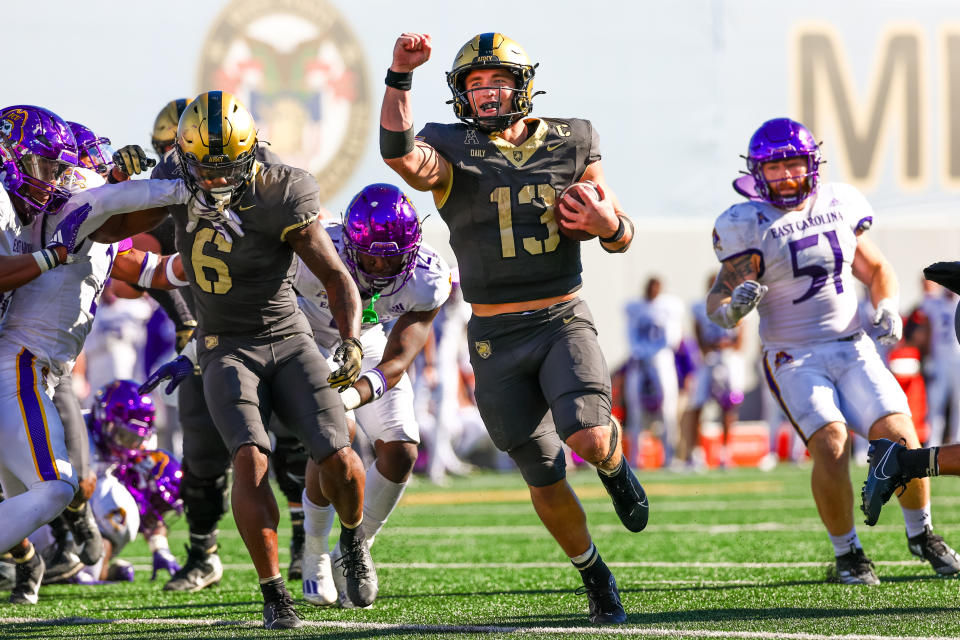History weighs on this weekend’s massive showdown between Army and Notre Dame. Once upon a time, this was the country’s most famous rivalry, a war that cast a spell on the entire country. Americans eagerly awaited the newspapers, gathered around the radios, and stared at the glow of the first mass televisions to find out which of these titans would win the best and biggest game of the year.
Army-Notre Dame inspired both — “The Four Horsemen Rode Again” by Grantland Rice, “Outlined Against a Blue-Gray October Sky,” andKnute Rockne’s plea “Win one for the Gipper.” It is the source of sports as myths, of coaches as stern but loving father figures, and of players as exalted or doomed heroes.
So it’s somehow perfect, narratively speaking, that this rivalry, which has fallen so far from its 20th century heights, could once again alter the trajectory of an entire sport. The business of college football today would be unrecognizable to Rockne, Red Blaik, Ara Parseghian and other legends of the Notre Dame-Army rivalry, but the main goal: evaluate that man on the other side of the line, beat him and let the cards fall Wherever they fall, it would be very familiar.
Army and Notre Dame won 16 national championships in the 20th century, including seven in the 1940s alone (technically six, since they share 1946). They have fallen a lot since then; Army’s last title season was in 1946, and Notre Dame’s was in 1988. The Irish have struggled to regain prominence ever since, using unlimited resources, a de facto personal broadcast network and a nationwide recruiting footprint .
The most interesting transformation is occurring at West Point, where the Army is making history on multiple fronts. The Black Knights (9-0) are one win away from just the fourth double-digit victory in the program’s 131-year history. You have to go back to 1958 to find the Army’s last undefeated season. Aside from a seven-year stint in Conference USA around the turn of the millennium, the Army has been a proud Independent until this year, when it broke into the AAC and took control of the whole.
The miracle here is how the Army has put itself in this position despite failing to take advantage of college football’s two momentous weapons: NIL and the transfer portal. The Army doesn’t allow its players to accept NIL money, and you don’t parachute into West Point for a single mercenary stint.
But it’s not hard to see how the Army’s old-school ethos is a counterintuitive benefit. While other AAC schools were being targeted for their top talent, or trying to form a group of unique bounty hunters, Army is forming a team. (Yes, this sounds like a commercial. That doesn’t make it any less true.)
Quarterback Bryson Daily, for example, played exactly one game as a freshman and didn’t throw a pass. He played five as a sophomore and scored two touchdowns on 12 rushing attempts. He took over the starting job as a junior and now, as a senior, leads all FCS quarterbacks in rushing yards and ranks second in rushing touchdowns with 21. That’s a wait-your-turn kind of attitude. Be ready when they call you. mentality that the portal and NIL have already devastated across the country.
As Florida State has shown to chilling effect, it’s not enough to bring in a group of top recruits, throw them a ball, and expect them to win games. Team cohesion also helps, the kind of cohesion that comes from living, eating, practicing and bleeding together for three or four seasons. NIL can hide many of the sins of college football, but it cannot replace them.
Army beats its opponents by grinding them into dust, holding the ball for much of the game and using opportunistic turnovers and a conservative ball-control offense to control the tempo. It is a way to defeat a physically superior opponent; Stay in the conversation long enough and you can take control of it… both in-game and in the season.
Admittedly, despite its spotless record, the strength of the Army’s schedule is a real concern. The Black Knights are 19th in the current CFP standings, behind a series of one-, two-, and three-loss teams. The SEC and the Big Ten can argue over who is the better conference; There are no such debates with the AAC.
That’s what makes this weekend’s Notre Dame rematch so compelling and crucial. Army now has the opportunity to change the entire playoff structure. All they have to do is snap a 15-game losing streak dating back to 1958 and overcome a projected 14.5-point deficit. But if Army can pull it off, everything opens up: A new Group of Five team is pushing its way into the playoff conversation, and the Irish are either completely out of the mix or trying to justify their entry against a team from the SEC with two losses. . And once the playoffs begin, who knows what could happen next? We’re in uncharted territory throughout the show.
Sure, Army-Notre Dame may never return to its glory days when it determined the fate of the college football universe. But it’s once again a crucial matchup to watch, and that’s one of many elements of this season worth celebrating.


